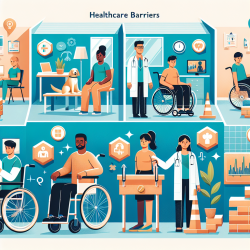Introduction
Adolescence is a critical developmental stage characterized by significant changes in behavior and brain function. Understanding the neural mechanisms underlying emotion regulation during this period is crucial, especially for practitioners working with high-risk adolescents. The study "Apples to apples? Neural correlates of emotion regulation differences between high- and low-risk adolescents" provides valuable insights into how adolescents process socioaffective cues and the implications for emotion regulation.
Key Findings
The research conducted by Perino et al. (2019) compares emotion regulation between low-risk community adolescents and high-risk delinquent adolescents using functional magnetic resonance imaging (fMRI). The study reveals distinct patterns in how these groups respond to socioaffective cues, which can inform practitioners in tailoring interventions.
- Community Adolescents: These adolescents exhibit greater difficulty regulating behavior in response to appetitive socioaffective cues, such as positive social interactions.
- Delinquent Adolescents: In contrast, high-risk adolescents show more challenges in regulating behavior when faced with aversive socioaffective cues, such as negative social interactions.
Neural Correlates
The study identifies key brain regions involved in emotion regulation, including the inferior frontal gyrus (IFG), medial prefrontal cortex (mPFC), and temporoparietal junction (TPJ). These regions are differentially recruited depending on the socioaffective context and the adolescent's behavioral profile.
- Inferior Frontal Gyrus (IFG): This region is crucial for inhibiting behavioral responses and focusing attention, especially in the presence of distracting socioaffective cues.
- Medial Prefrontal Cortex (mPFC): The mPFC is associated with monitoring errors and regulating impulsivity, playing a vital role in decision-making processes.
- Temporoparietal Junction (TPJ): Involved in social cognition, the TPJ helps process social cues and may influence attention and decision-making in social contexts.
Implications for Practitioners
Practitioners working with adolescents can leverage these findings to enhance their interventions:
- Tailored Interventions: Understanding the specific socioaffective cues that challenge different adolescent groups can help practitioners design more effective, personalized interventions.
- Focus on Neural Mechanisms: By considering the neural correlates of emotion regulation, practitioners can better understand the underlying mechanisms driving adolescent behavior and adjust their approaches accordingly.
- Further Research: Encouraging further research into the neural and behavioral differences between high- and low-risk adolescents can lead to more comprehensive strategies for managing emotion regulation challenges.
Conclusion
The study by Perino et al. (2019) highlights the importance of considering both behavioral history and socioaffective context in understanding emotion regulation in adolescents. By integrating these insights into practice, practitioners can improve outcomes for both high- and low-risk adolescents. For those interested in exploring this research further, the original study provides a detailed examination of the neural correlates of emotion regulation in adolescents.
To read the original research paper, please follow this link: Apples to apples? Neural correlates of emotion regulation differences between high- and low-risk adolescents.










